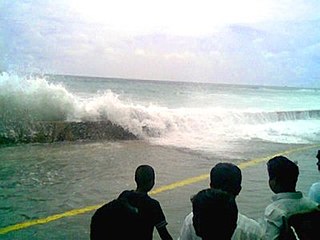Effect of the 2004 Indian Ocean earthquake on the Maldives


In the Maldives, 82 people were killed and 24 reported missing and presumed dead after it was hit by a tsunami caused by the 2004 Indian Ocean earthquake on 26 December 2004.[1] Two-thirds of the capital city Malé was flooded during the first hours of the day. Outlying low-level atolls were badly affected, and some low-lying islands, including some of the major resorts, were submerged at the peak of the tsunami.
The government declared a state of national disaster[2] and a special task force was set up to provide aid and supplies. Rescue efforts were hampered by loss of communication capability with the over one thousand islands that compose the nation, as well as by the lack of disaster planning.
Notes
External links
- Maldives Disaster Management Centre
- Photos from Malé, Maldives
- Blog with photos and thoughts from Maldives
- British Foreign Office advice for the Maldives.

